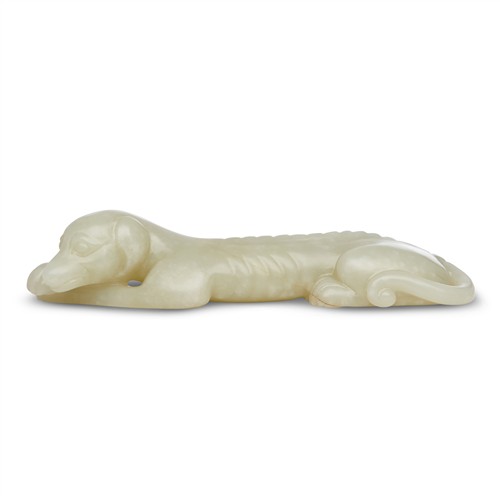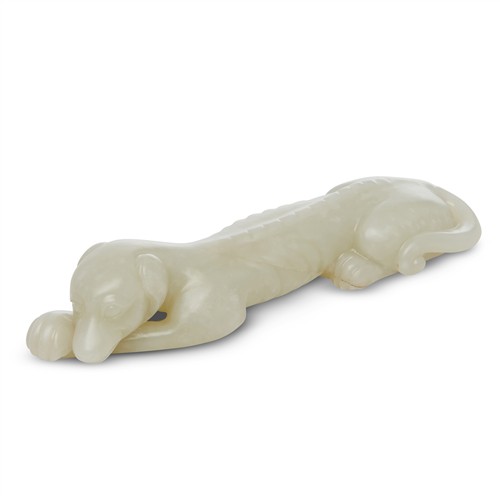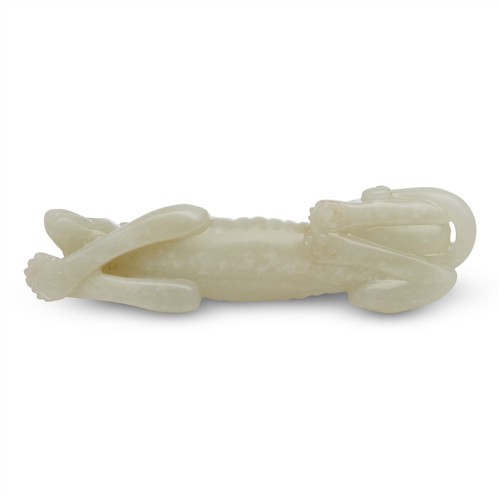Back
A CHINESE WHITE JADE CARVING OF A DOG, QING DYNASTY, 18TH CENTURY OR EARLIER
The reclining hound is carved with its head resting between the outstretched front legs. Its spine and folds on either side of the body are articulated with delicate lines and ridges ending to the rear with a softly coiled tail curled to one side above one leg, and the other leg tucked beneath the body.
Only a small number of jade carvings depicting hounds in this posture are known, typically dated between the Tang and Ming dynasties. A related example, carved from yellow and black jade with a raised head, comes from the Dr. Arthur Sackler Collection and is attributed to the Tang dynasty. It featured Chinese Jades Throughout the Ages, an exhibition held at the Victoria and Albert Museum in 1975 (no. 204), organized by The Arts Council of Great Britain and the Oriental Ceramic Society. Another yellow jade hound, formerly in the Joan Barrow, Lord and Lady Cunliffe, and Mary and George Bloch Collections, was most recently catalogued as Yuan/Ming dynasty. It is illustrated in Dr. Newton's Zoo, Bluett & Sons, London, 1981 (no. 22), and was later sold at Sotheby's Hong Kong, 23 October 2005, lot 20. A white jade hound in a similar posture, dated to the Ming dynasty or earlier, was sold at Christie's Hong Kong on 27 April 1997, lot 584. A russet jade male hound from the W.P. Chung Collection, dated to the Song dynasty, was exhibited in Chinese Jade Carving (1983, no. 136), jointly presented by the Min Chiu Society and the Hong Kong Museum of Art. Another Song-dynasty example, showing a hound turning its head toward its haunches, is illustrated by Jessica Rawson in "Chinese Jade from the Neolithic to the Qing" (1995, p. 336, no. 26:10), where she notes that such jade hounds may have been worn as symbols of hunting prowess.
清 十八世紀或更早 白玉臥犬雕件
犬首伏於前腿之間,脊背與身側褶紋刻劃細緻,尾部柔和盤曲於一側,一腿收於身下
此姿態玉犬雕件極為罕見,常見於唐至明代。類似器見:Arthur Sackler舊藏黃黑玉犬,唐代,展於1975年英國維多利亞與亞伯特博物館《歷代中國玉器展》,編號204
長14公分
源流:
W.Y. Thomas Kwok 遺藏,1980年代初購於香港
14cm long
Sold for $3,200
Lot 192
The reclining hound is carved with its head resting between the outstretched front legs. Its spine and folds on either side of the body are articulated with delicate lines and ridges ending to the rear with a softly coiled tail curled to one side above one leg, and the other leg tucked beneath the body.
Only a small number of jade carvings depicting hounds in this posture are known, typically dated between the Tang and Ming dynasties. A related example, carved from yellow and black jade with a raised head, comes from the Dr. Arthur Sackler Collection and is attributed to the Tang dynasty. It featured Chinese Jades Throughout the Ages, an exhibition held at the Victoria and Albert Museum in 1975 (no. 204), organized by The Arts Council of Great Britain and the Oriental Ceramic Society. Another yellow jade hound, formerly in the Joan Barrow, Lord and Lady Cunliffe, and Mary and George Bloch Collections, was most recently catalogued as Yuan/Ming dynasty. It is illustrated in Dr. Newton's Zoo, Bluett & Sons, London, 1981 (no. 22), and was later sold at Sotheby's Hong Kong, 23 October 2005, lot 20. A white jade hound in a similar posture, dated to the Ming dynasty or earlier, was sold at Christie's Hong Kong on 27 April 1997, lot 584. A russet jade male hound from the W.P. Chung Collection, dated to the Song dynasty, was exhibited in Chinese Jade Carving (1983, no. 136), jointly presented by the Min Chiu Society and the Hong Kong Museum of Art. Another Song-dynasty example, showing a hound turning its head toward its haunches, is illustrated by Jessica Rawson in "Chinese Jade from the Neolithic to the Qing" (1995, p. 336, no. 26:10), where she notes that such jade hounds may have been worn as symbols of hunting prowess.
清 十八世紀或更早 白玉臥犬雕件
犬首伏於前腿之間,脊背與身側褶紋刻劃細緻,尾部柔和盤曲於一側,一腿收於身下
此姿態玉犬雕件極為罕見,常見於唐至明代。類似器見:Arthur Sackler舊藏黃黑玉犬,唐代,展於1975年英國維多利亞與亞伯特博物館《歷代中國玉器展》,編號204
長14公分
源流:
W.Y. Thomas Kwok 遺藏,1980年代初購於香港
14cm long
Estimate $4,000 - $6,000
Overall in good condition.
CLICK TO SEE DETAIL PHOTOS OF THE WHOLE AUCTION


